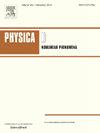Small-amplitude periodic solutions in the polynomial jerk equation of arbitrary degree
IF 2.7
3区 数学
Q1 MATHEMATICS, APPLIED
引用次数: 0
Abstract
A zero-Hopf singularity for a 3-dimensional differential system is a singularity for which the Jacobian matrix of the differential system evaluated at it has eigenvalues zero and ω with ω ≠ 0. In this paper we investigate the periodic orbits that bifurcate from a zero-Hopf singularity of the th-degree polynomial jerk equation ϕ, where ϕ is an arbitrary th-degree polynomial in three variables. We obtain sharp upper bounds on the maximum number of limit cycles that can emerge from such a zero-Hopf singularity using the averaging theory up to the second order. The result improves upon previous findings reported in the literature on zero-Hopf singularities and averaging theory. As an application we characterize small-amplitude periodic traveling waves in a class of generalized non-integrable Kawahara equations. This is accomplished by transforming the partial differential models into a five-dimensional dynamical system and subsequently analyzing a jerk system on a normally hyperbolic critical manifold, leveraging the averaging method and singular perturbation theory.
求助全文
约1分钟内获得全文
求助全文
来源期刊

Physica D: Nonlinear Phenomena
物理-物理:数学物理
CiteScore
7.30
自引率
7.50%
发文量
213
审稿时长
65 days
期刊介绍:
Physica D (Nonlinear Phenomena) publishes research and review articles reporting on experimental and theoretical works, techniques and ideas that advance the understanding of nonlinear phenomena. Topics encompass wave motion in physical, chemical and biological systems; physical or biological phenomena governed by nonlinear field equations, including hydrodynamics and turbulence; pattern formation and cooperative phenomena; instability, bifurcations, chaos, and space-time disorder; integrable/Hamiltonian systems; asymptotic analysis and, more generally, mathematical methods for nonlinear systems.
 求助内容:
求助内容: 应助结果提醒方式:
应助结果提醒方式:


